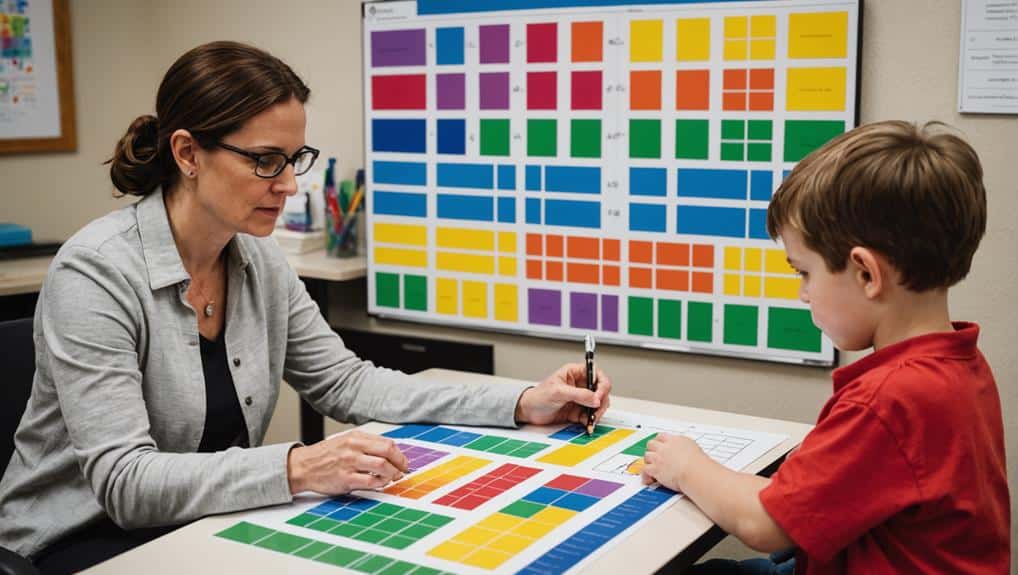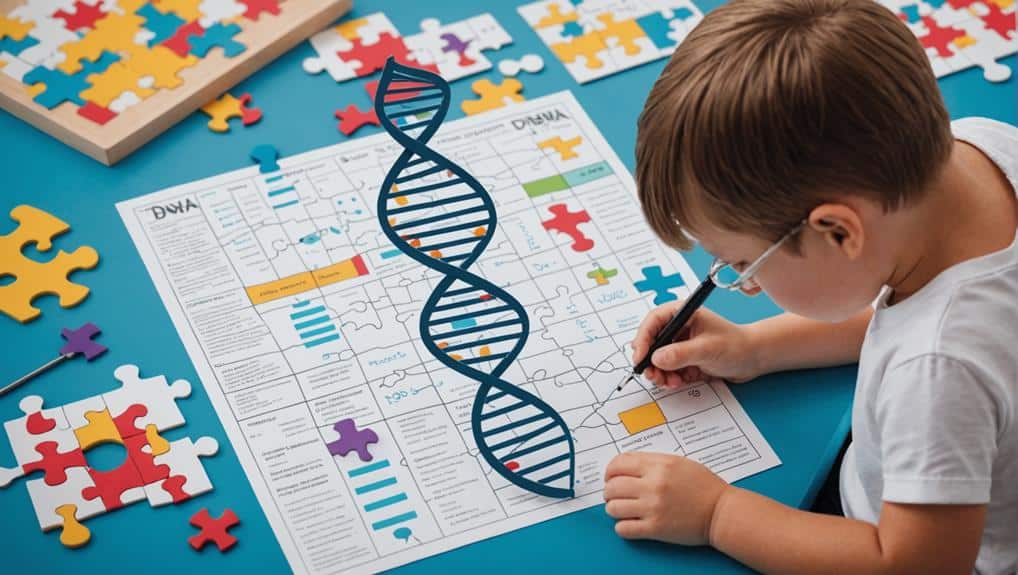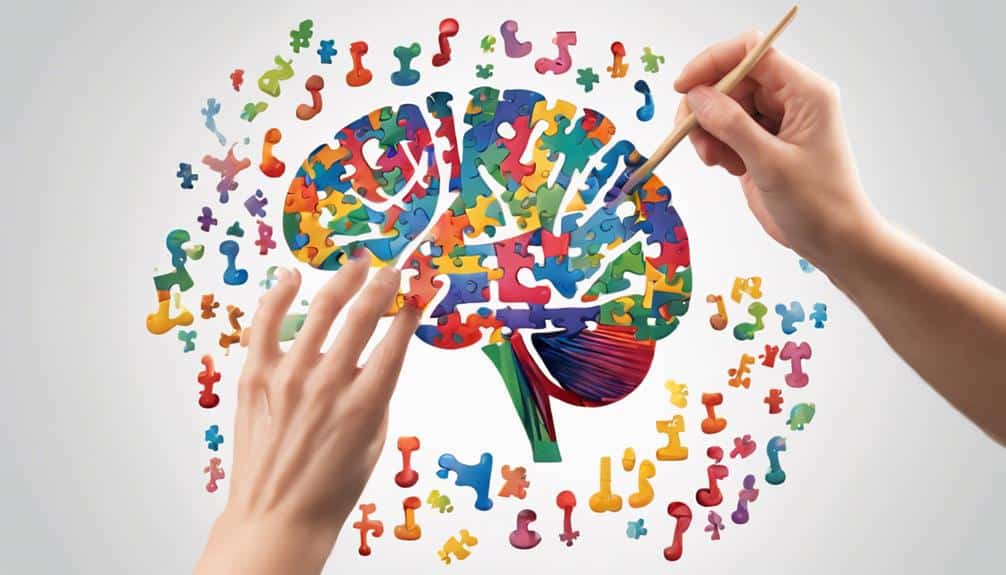Mastering autism care involves using various techniques to help your child grow and thrive. Each method offers unique benefits, from occupational therapy to behavioral strategies and early interventions. But finding the right approach isn’t always straightforward. It requires understanding your child’s needs and knowing which methods work best together.
As you explore these 15 effective strategies, remember that mastering autism care is a journey. There isn’t just one way to support your child. It’s about trying different techniques and seeing how your child responds. Are you ready to take this vital step toward a brighter future for your child?
Key Takeaways
- Implement early intervention programs to improve development outcomes and enhance social skills, communication, and behavior.
- Apply data-driven techniques like ABA assessments and therapy hours optimization for customized treatment strategies and progress tracking.
- Engage family in autism care for consistent support, skill retention, and creating a supportive environment.
- Utilize sensory aversion techniques and resources such as weighted blankets and sound-muting headphones to manage sensory dislikes.
- Enhance communication and social interaction by employing speech therapy, AAC systems, role-playing, social stories, and video modeling.
Understanding Autism Therapy Approaches
While many may find the realm of autism therapies intricate, understanding the different methods can significantly improve the effectiveness of care provided. Occupational therapists play a vital role in this process, working to boost an individual’s independence and quality of life. This therapy concentrates on improving motor skills, sensory processing, and daily living activities, making it a pivotal aspect of a thorough care plan.
In addition to occupational therapy, seeking assistance from developmental pediatricians or neurologists is recommended for early diagnosis and intervention. This can lead to timely access to appropriate therapies, improving long-term outcomes.
The role of Behavioral Therapy is equally significant, with Applied Behavior Analysis (ABA) and Cognitive Behavioral Therapy (CBT) being widely recognized for their effectiveness. ABA therapy, grounded in evidence-based research, helps enhance social interactions, communication, and learning skills through positive reinforcement. On the other hand, CBT proves effective in managing anxiety and challenging behaviors, which is essential for those with autism to navigate their world.
Another notable approach is to include early intervention programs in the preschool years, which profoundly impact child development. These specialized therapy programs offer structured interventions tailored to the distinct needs of each individual. Understanding these diverse therapy approaches can undoubtedly improve the quality of care provided to those with autism.
The Power of Early Intervention
Recognizing the potential of early intervention transforms the trajectory for children diagnosed with autism. Research-backed evidence consistently validates early intervention programs’ substantial positive impact during preschool in improving developmental outcomes. Often characterized by tailored support and therapies, these interventions equip children with enhanced social skills, communication abilities, and overall behavior.
Early intervention is not simply a reactive response to a diagnosis but a proactive, strategic method for child development. It is rooted in understanding and nurturing the child’s specific needs, which leads to more effective engagement in the learning process. This aligns with the need for parents to embrace and understand the individuality of their autistic children, which can contribute to more effective support mechanisms and interventions.
These interventions address developmental delays early, increasing the likelihood of successful integration into mainstream education settings. Parents’ early involvement, understanding, and acceptance help autistic individuals lead fulfilling lives.
The true power of early intervention lies in its future-focused perspective. Early interventions improve the child’s long-term language development and adaptive behavior outcomes. This potential to positively impact a child’s trajectory and quality of life exemplifies why early intervention is a cornerstone in mastering autism care. The value of these interventions is invaluable for those desiring to serve this community.
Significance of Progress Evaluation

The importance of progress evaluation in autism care cannot be overstated, as it is crucial to the child’s development. With the support of advocacy networks, parents and caregivers can access the necessary resources to improve their child’s development. A data-driven approach can be utilized by establishing measurable therapy objectives and ensuring the therapy is targeted and responsive to the child. By fostering respect and appreciation for neurodiversity, like the initiatives put forth by advocacy groups, we can better understand and respond to each child’s child’s needs. Analyzing these results can also help identify development patterns and optimize therapy outcomes.
Setting Measurable Therapy Objectives
Allocating measurable therapy goals is crucial in an autism care setting. These goals form the foundation of any therapeutic intervention, allowing for the careful tracking of progress and evaluation of effectiveness. Employing techniques such as planning scripts for common questions or sticking to usual routines can offer additional assistance in these interventions. By defining clear and specific therapy targets, therapists have a pathway for guiding children with autism toward developmental milestones, ensuring the unique needs of each child are met.
Setting measurable therapy goals offers several key benefits:
- It provides an objective method for evaluating the effectiveness of different therapeutic interventions.
- It allows therapists to adjust therapy strategies based on observable patterns in child development.
- It guides therapists in tailoring treatment plans to specific needs, ensuring that each child receives customized care.
- It forms the basis for data-driven approaches in therapy, enabling targeted and responsive interventions for children with autism.
Progress evaluation is of paramount importance in autism care. It allows for identifying successful strategies, areas of improvement, and the need for therapy adjustments. Therefore, setting specific, measurable therapy goals is not just beneficial but crucial for the holistic growth and development of children with autism.
Data-Driven Autism Therapy
Harnessing the potential of data in autism therapy illuminates the path to more effective interventions and informed decision-making. ABA assessments, a crucial element of data-driven approaches, enable therapists to tailor treatment plans and adjust strategies based on progress. Continuous data collection guarantees that therapy remains responsive to the individual’s needs and goals.
| Progress Evaluation | Purpose |
|---|---|
| Measure Objectives | Setting clear and measurable objectives helps track the development of skills and behaviors in individuals with autism. |
| Data Collection | Constant data collection allows for a responsive and adaptive treatment plan. |
| Progress Analysis | Analyzing progress data aids in adjusting therapy techniques and optimizing outcomes in autism care. |
Data-driven approaches in autism therapy provide a quantitative measure of progress and equip caregivers with insights to make informed decisions. They help identify interventions’ effectiveness, fostering a culture of continuous improvement in autism care. Such techniques guarantee that every effort is purposeful and enhances the child’s development.
Identifying Development Patterns
Shifting our focus to the significance of progress assessment, we find that it is a pivotal tool in identifying development patterns in autism therapy. This essential practice allows therapists to assess the effectiveness of their interventions and make informed decisions tailored to the child’s-distinct needs. With a keen understanding of challenges like eye contact for autistic individuals, therapists can devise suitable strategies that consider these difficulties.
By setting clear and measurable objectives, therapists can track developmental progress, providing valuable data insights that guide adjustments in therapy approaches. Acknowledging the impact of sensory issues on communication, accommodations can be made to reduce stress and foster a comfortable environment for therapy. This guarantees therapy remains responsive and tailored to the child’s child’s needs and developmental patterns. Measuring specific objectives and goals enables therapists to monitor progress and make evidence-based adjustments for the best outcomes.
In autism therapy, the following elements are of utmost importance:
- Progress Assessment: Regular evaluation of the development to gauge the effectiveness of interventions.
- Measurable Goals: Clear, quantifiable targets that provide a benchmark for tracking progress.
- Data Analysis: Examination of collected data to guide therapy adjustments.
- Continuous data collection: Ongoing child development tracking to ensure therapy is responsive and tailored.
Through these techniques, we can master autism care, enhancing the child’s development through a systematic, data-driven approach.
Advantages of Data-Driven Approaches
With the rise of technology, data-informed approaches have become a pivotal tool in autism care. These methods, such as DIR/Floortime and ABA assessments, provide valuable insights into determining the best number of therapy hours needed for effective treatment plans. This systematic collection and analysis of data enable therapists to make informed decisions and tailor customized treatment strategies for each unique individual with autism.
Continuous evaluation of progress data ensures that therapy remains responsive to each child’s needs and goals. It also allows necessary adjustments to be made in real-time, optimizing outcomes and enhancing the child’s developmental path. Data-informed approaches offer a measurable way to track the effectiveness of therapy interventions, providing both the therapist and the caregiver with a clear view of the child’s development.
Furthermore, using data insights in therapy does more than track progress. It guides therapists in making evidence-based decisions, leading to more targeted and impactful interventions. Consequently, data-informed approaches create a dynamic, responsive, customized autism care plan, enhancing child development and fostering a supportive and effective therapeutic environment.
Exploring Innovative Autism Therapies

Delving into the realm of pioneering therapies, we find a significant surge of promising advancements in autism care. These groundbreaking therapies aim to enrich child development and strengthen social interaction skills, language, and social communication abilities in people with autism.
The following therapies, supported by compelling scientific evidence, are contributing to a transformative shift in autism care:
- Balovaptan, a drug that modulates oxytocin receptors, has shown a 15% improvement in social interaction skills.
- Transcranial Magnetic Stimulation (TMS) is showing promise in enriching language and social communication abilities.
- Pressure chamber therapy is gaining traction due to its potential to boost social skills and improve brain function.
- Nirsevimab has positively improved social communication and cognitive abilities and reduced repetitive behaviors.
Furthermore, utilizing state-of-the-art technologies like virtual agents, Artificial Intelligence (AI), and Augmented Reality (AR) is revolutionizing therapy approaches by aiding communication and life skills development. These therapies, combined with a dedicated and compassionate care approach, are paving the way for a brighter future for individuals with autism.
Promising Drug Therapies Overview
As we navigate the landscape of autism care, promising drug therapies such as Balovaptan and Nirsevimab have emerged as significant players. Balovaptan, a drug that modulates oxytocin receptors, has been shown to improve social interaction by 15% in those with autism. This promising development in autism treatment is a guiding light of hope for those struggling with social skills.
Nirsevimab, on the other hand, has demonstrated its potential by enhancing social communication and cognitive abilities and reducing repetitive behaviors in children with autism. This drug therapy offers a promising approach to address specific challenges associated with autism spectrum disorder, improving the quality of life for these individuals.
The advancements in drug therapy research are undeniably encouraging. However, it is crucial to remember that these therapies are not cures but tools to support those on the autism spectrum better. Each step forward in this field brings us closer to a future where those with autism can optimize their potential and lead fulfilling lives. The path toward mastering autism care is a collective effort, and these promising drug therapies are significant milestones on this journey.
The Role of Genetic Research

Shedding light on the genetic underpinnings of autism spectrum disorder (ASD), genetic research has identified specific genes that contribute to the risk of ASD development. This genetic component is essential to understanding ASD, as it paves the way for personalized treatment strategies and provides insights into the biological mechanisms at play.
Genetic research has enriched our understanding of the complexity and variability of autism, revealing that:
- It is not a single-gene disorder but a complex interplay of multiple genes and environmental factors.
- Certain genetic variations may increase susceptibility to ASD, while others may confer resilience.
- Some genetic alterations may be inherited, while others occur spontaneously.
- Personalized treatment strategies are possible by utilizing the power of genetic research.
This understanding is paving the way for targeted therapies and interventions vital for individuals with autism. Embracing genetic research’s implications allows us to serve those with ASD better, acknowledging their distinct genetic makeup and tailoring strategies to their specific needs. We are not merely treating ASD but providing compassion and understanding for those on this path.
Technology Integration in Autism Care
In the field of autism care, the integration of technology is proving to be a game-changer. It offers interactive means to boost learning outcomes and promote independence in individuals with autism. Technology goes beyond the traditional boundaries of therapy, allowing for tailored therapy plans that target interventions customized to each person’s needs.
Technology integration facilitates the teaching and practice of social interaction, communication, and crucial daily living skills engagingly by utilizing diverse tools. This creative approach catalyzes growth, enabling individuals with autism to explore their world more confidently.
Family involvement is a critical element in this transformative process. The use of technology at home, as part of therapy, fosters an environment of continuous learning and skill generalization. Families, hence, become active participants in treatment, bolstering the effectiveness of interventions and contributing to the overall well-being of their loved ones. This symbiotic relationship between technology integration, customized therapy plans, and family involvement is redefining the landscape of autism care, providing a guiding light for families embarking on this path.
Benefits of Virtual Agents and AI

The emergence of virtual assistants and AI in autism care has resulted in significant advantages, particularly in reinforcing communication and social skills growth in individuals with autism. These innovative technologies have provided a platform for personalized, interactive experiences that support skill acquisition and generalization.
The following points highlight the notable benefits of integrating virtual assistants and AI into autism care programs:
- Virtual assistants offer a customized approach to meeting people and preferences, which boosts engagement and effectiveness in therapy sessions.
- Research emphasizes the positive impact of AI on improving life skills and independence in individuals on the autism spectrum.
- Through interactive experiences, individuals with autism can enhance their social interaction and communication skills in a controlled, secure environment.
- Utilizing virtual assistants and AI in therapy programs enhances overall well-being outcomes, improving the quality of life of individuals with autism.
Utilizing AI and virtual assistants to serve others, especially those on the autism spectrum, is a promising path to explore for improved development and independence.
Personalized Therapy Plans
Customized therapy plans emerge as a potent tool in autism care. They address the specific requirements of each individual on the autism spectrum, considering their particular obstacles, strengths, and preferences. By integrating a thorough treatment approach, these plans offer a guide for precise interventions, aiding skill development and enhancing overall well-being.
Personalized care plans are formulated based on in-depth assessments, data insights, and, significantly, family input. This cooperative approach ensures the therapy is pertinent and adaptable to the child’s strengths and preferences. It utilizes the child’s strengths and preferences, maximizing the efficiency of the intervention.
Lastly, while family participation is pivotal in devising and executing these customized therapy plans, it is equally crucial in broadening skills and promoting long-term success. With their profound understanding of the child’s daily life, families can assist in reinforcing skills acquired during therapy sessions, ensuring a holistic and enduring approach to autism care. The impact of personalized therapy plans goes beyond immediate treatment, nurturing lasting positive transformations.
Importance of Family Involvement

In the context of autism care and child development, the role of family involvement cannot be exaggerated. This active participation not only helps to translate the skills learned in therapy into daily life activities but also magnifies positive treatment outcomes. As we delve into this topic further, we will address how family involvement boosts communication, reinforces learned behaviors, and contributes to a more thorough approach to autism care.
Boosting Skills Generalization
Family engagement in autism care significantly improves skill generalization and the ability to apply learned skills to new situations. This engagement solidifies the bridge between therapy and day-to-day life, creating a seamless learning environment that nurtures skill retention. Through family participation, children with autism can experience a comprehensive approach that targets their development in all aspects of life.
Family involvement brings a multitude of benefits in improving skill generalization and overall development:
- Ensures consistency: Family engagement allows skills learned in therapy to be reinforced and applied at home, promoting ongoing learning.
- Supports skill retention: Practice at home helps children retain and strengthen new skills.
- Advocates for comprehensive development: Integrating therapy into daily routines encourages balanced growth.
- Increases independence: Children gain autonomy as skills are generalized across different environments.
Positive Impact Enhancement
Family participation plays a vital role in amplifying the positive impact of autism care techniques on child development. It is the foundation for applying skills acquired during autism therapy in the child’s life. This participation goes beyond being present in therapy sessions; it reinforces acquired skills and strategies in various settings.
Research highlights the effectiveness of family engagement in autism therapy. It has been shown to magnify the success of interventions and support long-term progress. Furthermore, this collaboration gives families the knowledge and tools to comprehend and address their children, supporting their development.
Establishing a supportive environment is another significant aspect where family involvement makes a notable difference. Increased family participation promotes better communication and nurtures the growth of social skills in children with autism. It fosters a feeling of security and acceptance in the child, emphasizing the positive influence of their participation. Hence, the essential role of families in autism care cannot be emphasized enough—they are the key drivers in boosting the effectiveness of therapy and paving the way for their child’s comprehensive development.
Managing Sensory Aversion Techniques
How can we effectively support children with autism in managing their sensory dislikes? The solution lies in utilizing strategic sensory dislike strategies tailored to each child’s sensory obstacles.
Occupational therapists play a crucial role in developing these approaches, thanks to their expertise in sensory processing. They can cultivate a sensory-friendly setting to alleviate stress and anxiety while enabling children to regulate their sensory encounters. Some of the resources utilized in this process include:
- Sensory routines: Personalized activities that aid children in staying attentive and organized throughout the day.
- Weighted blankets: These offer deep pressure that comforts and calms.
- Sound-muting headphones: These assist in controlling auditory stimuli.
- Visual timetables: These offer predictability, reduce anxiety, and promote autonomy.
Furthermore, tranquil sensory spaces and fidget tools can also be advantageous. Sensory dislike management involves comprehending the child’s requirements and employing practical tools and methods. By approaching sensory obstacles with compassion and comprehensive understanding, we can establish a more inclusive and supportive world for children with autism.
Dance Therapy and Emotional Well-being

In the field of autism care, dance therapy emerges as an incredibly beneficial technique for improving emotional well-being and social development in children. This therapeutic approach can promote self-awareness, creativity, and positive social interactions when tailored explicitly to each child’s needs.
Research indicates that rhythmic movement and self-expression nurtured in dance therapy help autistic children regulate emotions and boost self-esteem. Additionally, these sessions can noticeably decrease anxiety levels, a common challenge for those on the autism spectrum. Dance therapy allows children to express themselves verbally and in a sense of freedom and joy that can be life-changing.
Integrating dance therapy into autism care plans encourages emotional expression and improves social connections. As children learn to convey their feelings through movement, they experience an increased sense of control and empowerment, which results in a noticeable improvement in overall well-being.
Thus, dance therapy is a sturdy foundation in autism care, offering a distinct pathway to improving emotional health and social skills in a supportive, enjoyable environment.
Effective Communication Skill Development
Building practical communication skills is a crucial aspect of autism therapy, considering the obstacles children with autism often face in expressing themselves verbally and nonverbally. Strategies, including speech therapy, Augmentative and Alternative Communication systems, and social skills training, can significantly improve these children’s communication abilities. By tailoring these interventions with specific communication goals, we can boost their understanding of others and their ability to express their thoughts and needs.
Autism and Language Skills
While it is widely acknowledged that children with autism may encounter challenges in developing language skills, such as speech delays, limited vocabulary, and difficulty understanding and using language, various techniques and strategies are available to aid in their communication development.
- Early intervention in speech therapy can significantly improve communication skills, enabling them to express needs, thoughts, and emotions effectively.
- Augmentative and Alternative Communication (AAC) devices, such as picture boards or speech-generating devices, can support nonverbal individuals to overcome communication challenges.
- Structured routines and clear communication strategies can significantly improve language development.
- Incorporating visual supports can assist comprehension and language use in children with autism.
Speech therapy, language development, and addressing communication challenges are crucial to caring for children with autism. Utilizing these methods can empower these children, enriching their ability to express themselves and, ultimately, enhancing their quality of life. Remember, every child is unique; what works for one child may not work for another. It’s essential to tailor approaches to meet each child’s specific needs.
Social Interaction Techniques
Many children with autism may face hurdles in mastering practical communication skills vital for meaningful social interaction. Social interaction techniques focus on developing these skills, using strategies like role-playing, social stories, and video modeling to enrich their abilities. Compassionately designed methods can help children understand and navigate intricate social cues, promoting their active engagement and interaction.
Peer-mediated interventions and group therapy sessions serve as supportive platforms, fostering social engagement and communication. These strategies provide children with a safe environment to practice the skills they have developed in authentic scenarios. Moreover, social skills training programs target children’s social challenges, providing tailored solutions to improve their peer interaction.
Moreover, visual supports and social scripts are fundamental in teaching appropriate social cues and responses. These tools offer structured guidance, helping children anticipate and prepare for social situations. Essentially, these social interaction techniques foster communication skills and instill confidence in children with autism, enabling them to participate and thrive in social environments. Through such compassionate, detailed interventions, we can genuinely support and enrich child development within the autism spectrum.
Enhancing Non-Verbal Communication
Recognizing the importance of non-verbal communication skills, encompassing gestures, body language, facial expressions, and eye contact, is crucial in enhancing the interpersonal abilities of people with autism. These skills are essential for expressing emotions and understanding others, leading to improved social interactions and relationships.
The Applied Behavior Analysis (ABA) approach is particularly effective in addressing non-verbal communication deficits in persons with autism. This systematic method focuses on modifying behavior through reinforcement, offering a practical way to teach these essential skills.
Several techniques can be employed to amplify non-verbal communication abilities:
- We use visual aids like charts or images to represent different emotions or actions.
- It is creating social stories that illustrate different social situations and appropriate reactions.
- Implementing video modeling, where persons can watch and imitate actions shown in videos.
- Applying DIR/Floortime and/or ABA techniques encourages and reinforces desirable non-verbal behaviors.
Independence Through Occupational Therapy

Embracing occupational therapy offers a tangible pathway toward independence for children with autism. This specialized treatment boosts independence by refining daily living skills and enhancing functional abilities, positively impacting the child’s quality of life.
Occupational therapists utilize various methods to tackle these children’s sensory processing disorders, fine motor skills, and cognitive abilities. These skills are vital for self-care, organization, time management, and social interaction, all of which are necessary for a child’s independence.
Research highlights the significant benefits of occupational therapy for children with autism, demonstrating noticeable improvement in adaptive behaviors and overall functioning. Therefore, incorporating occupational therapy into the care plan for a child with autism can be a powerful tool for their progress toward independence.
Frequently Asked Questions
How can mastering autism care make a difference in my child?
Mastering autism care equips you with the tools and knowledge to support your child’s needs, fostering their growth and independence. Applying these strategies can create a more positive, structured environment that helps your child thrive.
What Are Coping Techniques for Children With Autism?
Coping techniques for autistic children range from sensory integration therapy, visual supports, and deep pressure therapy to relaxation exercises and social skills training. All aim to improve communication, reduce anxiety, and enhance social interactions.
What Are ADLS for Kids With Autism?
Activities of Daily Living (ADLs) for kids with autism encompass crucial tasks such as dressing, grooming, feeding, and toileting. Mastery of these skills promotes independence, improves quality of life, and boosts daily functioning.
What Is the Most Effective Intervention for Children with Autism Spectrum Disorder?
Applied Behavior Analysis (ABA) is widely recognized as the most effective intervention for children with Autism Spectrum Disorder. It focuses on behavior modification and promotes skill development, improving their independence and quality of life.
What Is the Best Treatment for Autism in the World?
The best treatment for autism globally recognized is a multidisciplinary approach combining Applied Behavior Analysis, early intervention programs, Cognitive Behavioral Therapy, and Occupational Therapy, tailored to specific needs for improved development outcomes.
Conclusion
To sum up, autism care is a complex process that combines early intervention, progress monitoring, data-driven strategies, cutting-edge therapies, and sensory techniques. These impactful methods, customized to meet the unique needs of each child, promote comprehensive development. Finally, the active participation of families and the utilization of therapies such as dance and occupational therapy showcase the potential for significant advancements in managing Autism Spectrum Disorder, ultimately improving the overall well-being of these children.


Recent Comments